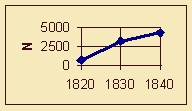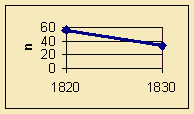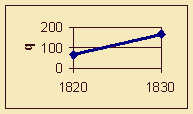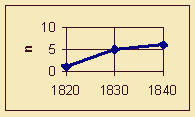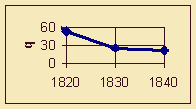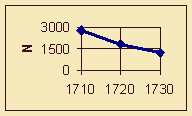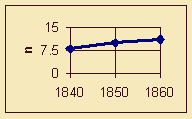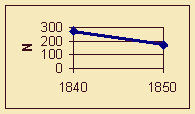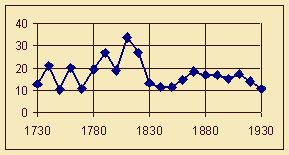Evolution of Artistic Life: Russian Literature and Russian Music in the 19th century (Quantitative Approach)
Beside stylistic changeability, art is supposed to possess certain changeability inherent in the INTENSITY of artistic life. Earlier this intensity was investigated on the creativity of 307 Russian poets and 480 prose-writers of the XVIIIth-XXth centuries (Petrov & Majoul, 2002). In the present paper these data are considered together with new data concerning Russian musical life of the XVIIIth-XXth centuries.
In line with the existing tradition (Martindale, 1990), the data on 4511 composers were taken out from an encyclopaedia, composers' years of birth and the length of an article devoted to each composer's creative activity (number of lines). All composers were grouped in 10-year intervals depending on their birthdates: 1750-1759, 1760-1769, ... . For each ten-year interval (t) the total NUMBER OF COMPOSERS (n) and the total NUMBER OF LINES devoted to them (N) were calculated. The last value (N) seems to be the indicator of the INTENSITY of musical life. After the analysis two hypotheses were put forward:
1. If the number of authors (n) serves as a factor of «popularity» or «prestige» of a particular kind of art in the professional artistic environment, there should be an indicator of «quality of intensity» - the «average mastery». This parameter is SPECIFIC INTENSITY q: q(t)=N(t)/n(t).
2. Changes in the intensity of artistic life have to be regarded as a dynamic process: each generation of authors keeps in mind the experience of the previous generation.
|

|
|
|
|
a) RISE (Russia)
|
c) ACCUMULATION (Austria and Germany)
|
e) EXTERNAL GROWTH (Denmark)
|
|
|
|
|
| a) DECLINE (Italy) | d) DISSIPATION (Czechia) |
f) EXTERNAL DESTRUCTION (Sweden) |
So, there are six versions of three changes in the intensity parameters (n, N and q) (Fig. 1a-f), which can be illustrated with the data on 4511 composers belonging to 17 national schools of music of the XVIIth-XXth centuries [in each case the upper curve responds to the number of authors (n), which is followed by the number of lines (N), and the value of the specific intensity (q)]:
a) n up, N up, q up - RISE. This way usually describes the creation of a national school. The given kind of art becomes popular in the professional artistic environment, the internal resources and mastery increase. So the potential of the national school is rather high. Example: Russia, 1830-49 (here and later birthdates of authors are meant).
b) n down, N down, q down - DECLINE. If this version of change in the intensity parameters continues for a long time, the potential of the national school is likely to be exhausted. Then, if any sources (internal or external) are not found, the national school disappears surely. Example: Italy, 1720-39c) n down, N up, q up - ACCUMULATION. The national school resists «author-replication» and so makes its potential raise. Popularity decreases, but this raise of the potential provides for one more RISE. Usually, the first one has already been before this period. Example: Austria and Germany, 1830-39.
d) n up, N down, q down - DISSIPATION. After major achievements of the national school, the popularity of the given kind of art grows rapidly (at the expense of the internal potential exhausting). Example: Czechia, 1850-69.
e) n up, N up, q down - EXTERNAL GROWTH. The internal potential of the national school decreases, but the intensity grows. This fact can be explained only by influence of another national schools, kinds of art or other external causes (Denmark, 1830-49).
f) n down, N down, q up - EXTERNAL DESTRUCTION. The national school accumulates its internal resources, but popularity of the kind of art declines. So there are some external causes (political, religious, social, cultural, etc.) that refuse the successful development of the national school (Sweden, 1850-59).
The analysis of these three parameters of intensity of RUSSIAN ARTISTIC LIFE revealed the following conclusions illustrated with Fig. 2-4:
|
|
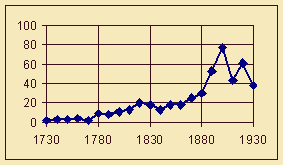
 |
| Figure 2. Evolution of Russian poetry | Figure 3. Evolution of Russian prose |

|
| Figure 4. Evolution of Russian music |
1. Before 1795 changes in all three intensity parameters both of prose and poetry are the same. It's likely to mean that there was no distinction between poets and prosaic writers in Russia at that time.
2. 1775-1799. Russian poetry, prose and music experience a RISE.
3. 1805-1819. Russian poetry deteriorates as a result of external causes (EXTERNAL DESTRUCTION), so it virtually vanishes after 1845.
4. A RISE in Russian prose (1805-1819) provides for another one (1845-1869).
5. From 1805-1819 the changes in the intensity parameters in prose are different from those ones in poetry (unlike the period before 1795). So Russian literary authors start to distinguish themselves either as prose-writers (N. Gogol', I. Turguenev) or poets (F.Tyutchev, E. Baratynsky,).
6. Russian music in 1805-1819 and literature in 1820-1829 experience EXTERNAL GROWTH. The external cause of this growth was «realism» as a popular artistic method (A. Dargomyzhsky, A. Ostrovsky, N. Nekrasov, F. Dostoevsky, M. Saltykov-Shchedrin, N. Tchernyshevsky, L. Tolstoy).
7. After 1840 the intensity of musical life presents itself a self-organizing system: RISE - DISSIPATION - ACCUMULATION - RISE (Example: P. Tchaikovsky, N. Rimsky-Korsakov - A. Lyadov, S. Taneyev - A. Glazunov, A. Arensky, A. Scriabin, S. Rakhmaninov - N. Myaskovsky, I. Stravinsky).
8. The entire evolution of intensity of Russian literary life is (excluding RISES) only affected by external causes.
References
Martindale, C. (1990). The Clockwork Muse: The Predictability of Artistic Change. New York: Basic Books.
Petrov, V.M., & Majoul, L.A. (2002). Pulsation of literary life: Periodical behavior of Russian poetry and prose in light of the information approach. Rivista di Psicologia dell'Arte, Nuova Serie, Anno XXIII, No. 13, 25-40.

